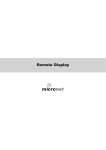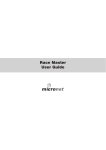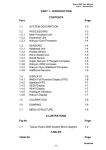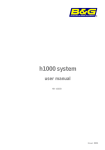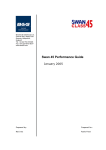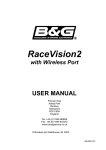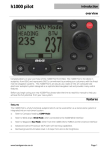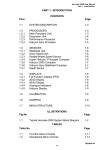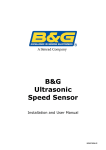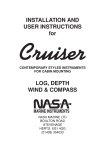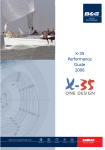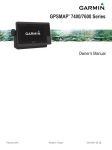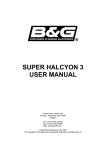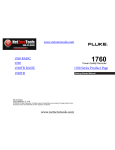Download HB-0913-02 _RmV User Manual
Transcript
RemoteVision with Wireless Port User Manual Premier Way Abbey Park, Romsey Hampshire, SO51 9DH, UK www.BandG.com © B&G Ltd. 2004 The copyright of this manual is the property of B&G Ltd. Intentionally Left Blank HB-0913-02 CERTIFICATION This equipment generates, uses, and can radiate radio frequency energy and, if not installed and used in accordance with the instructions, may cause harmful interference to radio communications. However, there is no guarantee that interference will not occur in a particular installation. If this equipment does cause harmful interference, the user is encouraged to try to correct the interference by relocating the equipment or connecting the equipment to a different circuit. Consult an authorised dealer or other qualified technician for additional help if these remedies do not correct the problem. RemoteVision meets requirements for CFR47 Part 15 of the FCC limits for Class B equipment. RemoteVision meets the standards set out in European Standard EN 60945: 1997 IEC 945: 1996 for maritime navigation and radiocommunication equipment and systems. TRADEMARKS All rights reserved. No part of this manual may be reproduced or transmitted in any form or by any means including photocopying and recording, for any purpose without the express written permission of B&G. Information in this document is subject to change without notice. B&G reserves the right to change or improve its products and to make changes in the content without obligation to notify any person or organisation of such changes. B&G, and RemoteVision are all trademarks of Brookes & Gatehouse Ltd. and may not be used without the express permission of Brookes and Gatehouse Ltd. (i) HB-0913-02 PRODUCT LIABILITY AND SAFETY WARNINGS Product Liability Brookes and Gatehouse Ltd. accept no responsibility for the use and/or operation of this equipment. It is the user’s responsibility to ensure that under all circumstances the equipment is used for the purposes for which it has been designed. Warning – Electrical Hazard This equipment uses high voltage electrical power. Contact with high voltages may result in injury and/or loss of life. Warning - Calibration The safe operation of this equipment is dependent on accurate and correct calibration. Incorrect calibration of this equipment may lead to false and inaccurate navigational readings placing the vessel into danger. Warning – Communication Limitations This equipment is designed as an aid to navigating with the Hydra and Hercules instrument systems and Pilots. This equipment communicates wirelessly with the installed instrument system. It is possible that the wireless link will fail due to a variety of reasons including, but not limited to, low battery power, travelling out of communication range and high levels of RF interference. Users should be aware that failure of the wireless link would lead to the inability to communicate with the instrument and Pilot system including an inability to alter pilot course, engage and/or disengage the Pilot from the RemoteVision. Caution The system electronics are designed for use with a battery power supply source of 3V dc. The application of any other power supply may result in permanent damage to the equipment. Caution The use of solvent based or chemical cleaners on RemoteVision will result in damage and invalidate your warranty. Caution RemoteVision contains no user-serviceable parts. Repairs should only be made by an authorised service centre. Unauthorised repairs or modifications may invalidate the warranty. HB-0913-02 (ii) RemoteVision User Manual Contents CONTENTS INTRODUCTION ........................................................................................................... 3 REMOTEVISION FEATURES ......................................................................................................3 W IRELESS PORT FEATURES ....................................................................................................3 GETTING STARTED..................................................................................................... 4 PACK CONTENTS ....................................................................................................................4 OVERVIEW .............................................................................................................................4 INSTALLING THE BATTERIES ....................................................................................................5 USING YOUR REMOTEVISION ...................................................................................................6 SWITCHING ON ......................................................................................................................7 MENU NAVIGATION .................................................................................................................7 SWITCHING OFF .....................................................................................................................7 PAIRING WITH INSTRUMENTS ...................................................................................................8 OPERATION ............................................................................................................... 10 MAIN MENU..........................................................................................................................10 INSTRUMENTS........................................................................................................... 10 INSTRUMENT DATA PAGES ....................................................................................................10 CHANGING DATA FUNCTIONS ................................................................................................11 CALIBRATION .......................................................................................................................12 PILOT .......................................................................................................................... 14 PILOT STATUS PAGE.............................................................................................................14 SWITCHING THE PILOT ON ....................................................................................................14 SWITCHING THE PILOT OFF ...................................................................................................14 SETTING THE PILOT COURSE.................................................................................................14 PILOT STEERING MODES.......................................................................................................16 PILOT SETTINGS ...................................................................................................................18 HAND COMPASS ....................................................................................................... 19 TAKING BEARINGS ................................................................................................................19 REVIEWING STORED BEARINGS .............................................................................................19 INSTRUMENT CONTROL .......................................................................................... 20 20/20 AND 40/40 SETUP ......................................................................................................20 BACK LIGHTING ....................................................................................................................20 TIMER ......................................................................................................................... 21 TIMER PAGE ........................................................................................................................21 SETTING THE TIMER..............................................................................................................21 SETUP......................................................................................................................... 22 COMPASS CALIBRATION ......................................................................................... 24 ENTERING THE COMPASS SETUP PAGES ................................................................................24 SWINGING THE COMPASS .....................................................................................................24 REMOTEVISION WIRELESS PORT INSTALLATION ............................................... 25 INTRODUCTION .....................................................................................................................25 LOCATION ............................................................................................................................25 CONNECTION .......................................................................................................................25 W IRING INFORMATION ..........................................................................................................26 1 HB-0913-02 RemoteVision User Manual Contents Intentionally left blank HB-0913-02 2 RemoteVision User Manual Introduction INTRODUCTION Congratulations and thank you for choosing the B&G RemoteVision, the world’s first personal wireless instrument and Pilot control. RemoteVision represents B&G’s commitment to provide systems of the highest quality and performance that are designed to function within the harsh marine environment. To get the most from your new RemoteVision, please take the time to carefully read this user manual so that you can fully appreciate its operation. RemoteVision Features • • • • • • • • • 100 x 128 pixel, transflective LCD display Rugged ABS enclosure, sealed to IP68 standards Backlit electroluminescent display, with white LED for keypad Automatic backlight illumination 20° fully gimballed fluxgate compass Powered by two AA 1.5V batteries, standard or rechargeable Wireless link to B&G RemoteVision Wireless Port High brightness white LED torch Up to 60 hours continuous usage battery life Wireless Port Features • Rugged ABS case • Wireless link to B&G RemoteVision • Direct link to B&G Hydra and Hercules Fastnet databus 3 HB-0913-02 RemoteVision User Manual Operation GETTING STARTED Pack Contents Ensure that your package includes all of the items listed below. If any parts are found to be missing, contact your B&G dealer immediately. RemoteVision • • • • • • • B&G RemoteVision Unit RemoteVision Wireless Port Holster Lanyard User Manual Quick Reference Guide AA Batteries (2) Overview Torch Torch button Compass Guide Keypad Battery Cover latch Compass Guide Lanyard Attachment HB-0913-02 4 RemoteVision User Manual Operation Installing the Batteries RemoteVision uses two “AA” Alkaline batteries located in the rear of the unit. Most alternative batteries are also suitable though some types may have magnetic properties that adversely affect compass accuracy. During battery replacement, individual user settings are stored in non-volatile memory to prevent loss of data. It is recommended that the internal fluxgate compass is always re-swung after battery replacement, to correct for possible magnetic differences between types of battery. Refer to the Setup section of this user manual for further details. Battery Replacement: 1. Using a coin, rotate the battery compartment screw ¼ turn anti-clockwise until the slot aligns with the open padlock symbol, remove the battery cover and the old batteries. 2. Insert new batteries observing the correct polarity and direction by referring to the symbols moulded into the battery compartment housing. 3. Check that the battery compartment seal is clean and undamaged. 4. Replace the battery compartment cover and lock into place by rotating the battery compartment screw ¼ turn clockwise until the slot aligns with the closed padlock symbol. Notes on battery life and replacement: • Use only new or fully recharged batteries • Do not mix different types of battery. • Generally, fresh alkaline batteries will have more power and capacity when compared to rechargeable batteries. • Significant use of the backlighting and torch will considerably reduce the battery life. • It is recommended that the batteries are removed from the RemoteVision if it is not going to be used for an extended period. 5 HB-0913-02 RemoteVision User Manual Operation Using your RemoteVision The following pages describe how to operate the most common features found on the RemoteVision. ON Key • When the unit is OFF: Pressing the ON key will switch the RemoteVision on • When the unit is ON: Pressing the ON key will engage the autopilot (if installed) OFF Key • When the unit is ON: Pressing the OFF key will disengage the autopilot if it is engaged. • Pressing the OFF key for approximately 2 seconds will switch the RemoteVision off NavStick The NavStick operates in a similar way to a joystick and allows you to quickly and easily navigate through menus. The NavStick is controlled with your thumb and may be moved in five directions: Up - typically for selecting menu items or entering figures Down - typically for selecting menu items or entering figures Left - typically for escaping from a sub-menu Right - typically for scrolling through page selections Inwards - for confirming selections Dodge Left Key When the autopilot is engaged, press the Dodge Left key to turn the autopilot to port. Multiple presses are added together. Dodge Right Key When the autopilot is engaged, press the Dodge Right key to turn the autopilot to starboard. Multiple key presses are added together. Torch Key Press and hold the Torch key on the rear of the unit to activate the torch. Releasing the key deactivates the torch. HB-0913-02 6 RemoteVision User Manual Operation Switching On Press the ON key to switch the RemoteVision on. The display shows “Connecting...” to indicate that RemoteVision is attempting to establish a connection with your instrument system. The Main Menu is displayed when the communication link has been established. The first time you turn the system on you will be prompted to pair the RemoteVision with the instrument system (see Pairing with Instruments below). Menu Navigation After communications are established the Main Menu is displayed and you are able to navigate through the menu structure. Using the NavStick, use the Up and Down actions to move the highlight bar through the displayed menu choices and then press the NavStick inwards to confirm your decision. Moving the NavStick to the left is similar to an ‘escape’ key and allows you to quickly return to the Main Menu from anywhere within the system. Switching Off To switch the RemoteVision off, press and hold the OFF key until “Powering Down…” is displayed. 7 HB-0913-02 RemoteVision User Manual Operation Pairing with Instruments To use your RemoteVision with the instrument system it is necessary to “pair” the unit with your Wireless Port. During this procedure it is important that the RemoteVision is within range of the Wireless Port. The Pairing procedure is required the first time the unit is used. Pairing with the Wireless Port Press the ON key to switch the RemoteVision on. If the unit is not paired with the Wireless Port the Main Menu will immediately appear as shown on the left. If the Main Menu appears in full (i.e. with Instruments as the top item) the unit is already paired and no further action is required. Set the Wireless Port PIN code On any FFD on the instrument system select BASE STN from the MISC menu on the upper line of the display. On the lower line of the display SCROLL DOWN to CALBRATE, then CAL VAL 2, then press ENTER to display the PIN code for the Wireless Port. You may set your own PIN code by pressing ENTER, then SCROLL UP/DOWN until you have selected your choice of PIN, press ENTER to fix your PIN number. Setting the Wireless Port into Pairing Mode After you have set the PIN code SCROLL DOWN to CAL VAL 1, press ENTER to display the PAIR setting which will be set to “0”. Press ENTER, then SCROLL UP so that the PAIR setting is “1”, press ENTER. At this stage the Wireless Port becomes “visible” to the RemoteVision for a short period of approximately one minute. HB-0913-02 8 RemoteVision User Manual Operation Completing the Pairing Whilst the Wireless Port is “visible” it is necessary to select “Pair Device” on the RemoteVision, this is found under Setup – Wireless – Pair Device. After selecting Pair Device there will be a short delay while the RemoteVision searches for Wireless Ports in range. After this period the unit should report “Device Found”, followed by the details of your Wireless Port. Select your Wireless Port from the list (there will usually only be one on the list) by pressing the NavStick. You will be prompted to enter your PIN code, enter the same PIN for the Wireless Port (above). Numeric values are entered using the NavStick: • Highlight the number field to edit using up/down on the NavStick • Press Enter to enable editing • Select the figure to edit using left/right on the NavStick • Alter the figure selected using up/down on the NavStick • When complete confirm by clicking the NavStick inwards Once you have confirmed the PIN the unit should connect and display the full Main Menu after a short delay. 9 HB-0913-02 RemoteVision User Manual Operation OPERATION Main Menu The Main Menu is shown at power up whenever there is a connection with the Wireless Port. During operation you can access the Main Menu from any screen, repeatedly click the NavStick to the left. Use the NavStick Up and Down actions to move the highlight bar through the displayed menu choices and then press in the NavStick to select your choice. INSTRUMENTS RemoteVision is pre-programmed from the factory with three default data pages. These pages are selected using the NavStick right function to cycle through each page in turn. Use the NavStick left action to return you to the Main Menu. The flexibility of RemoteVision allows for a number of display formats to suit your individual needs. Instrument Data Pages Data Page 1: Instrument Data x4 Data Page 2: Instrument Data x7 HB-0913-02 10 RemoteVision User Manual Operation Data Page 3: Time Plots Changing Data Functions To change the default data page functions, use the NavStick Up and Down action to highlight an individual data field, and then press the NavStick to confirm. Highlight Select New from the menu and press Enter to confirm. Use the NavStick to select the menu group that you require (e.g. “Speed” or “Depth”) and press the NavStick to confirm. These menu groups and functions are identical to your h2000 instrument displays. Next, choose the function that you desire from within your selected directory. The screen will now return to the data page and the new function is displayed. This procedure is the same for the Instrument, Timeplot and Pilot pages. 11 HB-0913-02 RemoteVision User Manual Operation Calibration The RemoteVision has access to all the calibrations, alarms and damping values from the h2000 instrument system, for specific calibration details consult your instrument system user manual. Calibration Example – Standard Calibrations To calibrate a function, highlight it on a data page – if the function is not displayed on a data page then you need to select it as above – press the NavStick to select. Highlight CALIBRATE from the menu and press the NavStick to select. Use the NavStick to highlight the relevant calibration value and press the NavStick to select – in the case of Depth there is only one calibration “DATUM” Highlight the calibration value, press the NavStick to enable editing of the value. Using the NavStick up/down/left/right modify the calibration value until it is as desired. Press the NavStick to confirm the value. Highlight OK and press the NavStick, the calibration value will be changed and you will return to the instrument data page. HB-0913-02 12 RemoteVision User Manual Operation In addition to the straightforward single number calibrations the RemoteVision can be used for editing the h2000 system’s calibration tables for True Wind Angle, True Wind Speed etc. Calibration Example – Editing Tables When editing tables the RemoteVision is an invaluable tool as it allows you to view the majority of the table at once, rather than only viewing individual cells. First you need to enter the calibration mode as above, in this example we are changing a calibration for True Wind Angle. When the Correction Table is displayed we need to select it for editing. Highlight the table with the NavStick, then Enter (press NavStick inwards). At this stage it is possible to scroll around the table using the NavStick, highlighting individual cells. Highlight the cell in the table you wish to modify, press and hold in the NavStick for about three seconds. At this stage the RemoteVision prompts you to edit the value in the same way as a normal calibration. 13 HB-0913-02 RemoteVision User Manual Operation PILOT The Pilot Data Page is available when a B&G autopilot is connected to the system. To access this page select Pilot from the Main Menu. Note that any Pilot control (On, Off or Course change) will automatically display this page. Pilot Status Page Pilot Steering Mode Compass Wind Waypoint etc. Pilot Status ON or OFF Response Level Economy Normal Perf1 etc. Instrument Data Two selectable values Action Field e.g. "Tack" or "Gybe" Target Bearing or Target Wind Angle Off Course indicator or Rudder Angle This screen is used to fully control the autopilot. Dependent upon the status of the Autopilot, the status field will be shown either as OFF or ON. Switching the Pilot On Pressing the ON key engages the autopilot in the currently selected mode. The Pilot page does not need to be displayed for the Pilot keys to operate. Switching the Pilot Off Pressing the OFF key disengages the autopilot. The Pilot page does not need to be displayed for the Pilot keys to operate. Setting the Pilot Course The Pilot course is altered by the Dodge Keys, each individual press of a Dodge key will alter the target course by a preset amount. The size of each course change is controlled by the Dodge Angle setting in Pilot Settings. HB-0913-02 14 RemoteVision User Manual Operation Pilot Mode Selection The Pilot Mode can be altered by selecting the Pilot Steering Mode on the Pilot page as shown above. Choices shown may differ from your system depending on the system configuration, refer to your Pilot user manual for details on the specific Pilot modes and options. Response Setting To alter Pilot Response Level select the Response Level on the Pilot page as shown above. Choices shown may differ from your system depending on the system configuration. Action Field When it is possible to carry out an action such as Tacking, Gybing, confirming course change for next waypoint etc. the Action field will display this option. To carry out the action select it from the Pilot page. A secondary confirmation page appears where you may confirm or cancel the action. 15 HB-0913-02 RemoteVision User Manual Operation Pilot Steering Modes Compass Mode With Compass Mode selected and the autopilot switched OFF, steer the boat onto the desired heading and allow the boat to settle. Engage the autopilot in Compass Mode by pressing the ON key once. The screen changes to show Pilot ON and Set CRS (Course). An off course indicator is also shown at the bottom of the screen. Altering Course Press the Dodge Port or Dodge Starboard keys to alter the course by the pre-set value (see Dodge Angle in Pilot Settings) Multiple presses of the Dodge keys are added together to apply the desired course change. Wind Mode In Wind Mode, the autopilot will steer a course that maintains a set target Apparent Wind Angle (Set AWA) or True Wind Angle (Set TWA). If the wind shifts, the autopilot will alter course so that the actual wind angle to the boat remains the same. With Wind Mode selected, steer the boat until the desired AWA or TWA is displayed and allow the boat to settle. Engage the autopilot in Wind Mode by pressing the ON key once. Altering Target Wind Angle Press the Dodge Port and Dodge Starboard keys to alter the Set AWA or Set TWA by the pre-set value in Dodge Angle. Multiple presses of the Dodge keys are added together. Smart Tack and Gybe RemoteVision allows you to initiate the h2000 Pilot tack or gybe functions. The Smart Tack and Gybe facility is selected by highlighting the Tack or Gybe legend in the Action field, and then pressing the NavStick to confirm your decision when prompted. HB-0913-02 16 RemoteVision User Manual Operation Optimum Wind Angle Mode When a Performance Processor is connected to the h2000 instrument system, the autopilot has the facility to steer to Optimum Wind Angle taken from the Performance Processor’s polar table. With OPT WA Mode selected, engage the autopilot by pressing the ON key once. Pressing either of the Dodge keys in Optimum Wind Angle Mode will automatically switch the autopilot into Compass Mode and allow you to safely steer around the obstacle. Waypoint Mode In Waypoint Mode, the autopilot can be used to steer to a waypoint received from an external source via NMEA. With Waypoint Mode selected and the Autopilot switched off, steer the boat onto the Bearing To Waypoint (BTW), ensure that the cross track error is less than 0.1Nm, and allow the boat to settle. Engage the autopilot in Waypoint Mode by pressing the On key once. Automatic Waypoint Advance Most position fixers and chartplotters will automatically switch to the next waypoint in a route. For reasons of safety however, the autopilot does not automatically steer to the next waypoint. RemoteVision prompts the user with Next Waypoint on the screen. When it is safe to do so, press the NavStick Enter action to instruct the autopilot to alter course towards the next waypoint in the route. Pressing either of the Dodge keys in Waypoint Mode will automatically switch the autopilot into Compass Mode and allow you to safely steer around the obstacle. 17 HB-0913-02 RemoteVision User Manual Operation Pilot Settings Pilot Settings Menu The Pilot Settings menu is accessed from the Pilot Screen by clicking the NavStick to the right. Dodge Angle The Dodge Angle is used to adjust the pre-set number of degrees that the autopilot turns by when either of the Dodge keys are pressed. This setting is the same for both the Compass and Wind Modes. For example, a setting of 5° applies a 5° heading change in Compass Mode and a 5° wind angle change in Wind Mode. Speed Source The Speed Source option allows the source for speed data to be selected. Three choices are available, Boat Speed, SOG and Fixed. The Fixed option activates a further two screens that allows manipulation of the three manual speed settings, Slow, Medium and Fast. Adjust these values to the most appropriate values for your boat. Wind Angle On the latest Hydra and Hercules Pilots it is possible to switch between Apparent and True Wind Angle steering. HB-0913-02 18 RemoteVision User Manual Operation HAND COMPASS The Hand Compass enables the user to take a bearing with the integral fluxgate sensor. Taking Bearings • • • Sight the target through the RemoteVision aligning the unit using the alignment guides Press either of the Dodge Keys to record the bearing, the bearing is stored in the currently displayed memory slot (“P1” in the example left) To change the memory slot in use scroll up or down with the NavStick Reviewing stored bearings After storing bearings they can be reviewed by scrolling right with the NavStick. There are ten memory slots available to the user for storing bearings. Scrolling left returns to the Hand Compass main page, a second scroll left returns the user to the main menu. 19 HB-0913-02 RemoteVision User Manual Operation INSTRUMENT CONTROL The Instrument Control function allows you to control 20/20 or 40/40 displays and also allows you to set the lighting level on the instrument system. 20/20 and 40/40 Setup The 20/20 and 40/40 setup page shows the currently displayed functions on each 20/20 (or 40/40) display To alter a displayed function 1. scroll up or down using the NavStick to select the 20/20 display you wish to change 2. click the NavStick in – the selected 20/20 will start flashing 3. scroll up/down to select one of the preset functions stored in the 20/20 display 4. click the NavStick in to confirm your selection If you wish to change one of the functions stored in the 20/20 follow the above steps (1) and (2) to select the function you wish to overwrite, then click the NavStick to the right to enter the menu structure and select a new function as you would for the Instruments pages. Back Lighting The Instrument Control Back Lighting function adjusts the lighting level intensity for system displays. Note Any displays set into Local lighting mode will not be affected by the lighting control command from the RemoteVision. Refer to the instrument user manual for more information. HB-0913-02 20 RemoteVision User Manual Operation TIMER The Timer function provides full control of the instrument system timer. Timer Page The Timer page displays the current timer value and gives the timer control options: Set Allows the user to choose the countdown time Sync Selecting “Sync” resets the Timer to the nearest whole minute during count up/down. Start Starts the Timer from the value chosen via the Set command Setting the Timer The Timer can be set to count-down over a user selectable period. When the Timer reaches zero it starts to count up to give an elapsed race time. The Timer can be used to count up by setting the Set Countdown function to zero minutes. 21 HB-0913-02 RemoteVision User Manual Operation SETUP The Setup menu provides access to less commonly used functions such as the Backlighting, Keylock, Sleep Mode and Contrast. Back Lighting The Setup Back Lighting function adjusts the lighting level intensity for the RemoteVision display. The backlight on the RemoteVision will automatically switch itself off after a short time, and then switch back on whenever a key is pressed. If the Auto mode is selected the lighting will switch on automatically when a key is operated only if the ambient light levels are low. Sleep Mode Sleep Mode allows the unit to power off when it has not been used for a period of time set by the user. Set Sleep Time: Set Sleep Time Page Key Lock HB-0913-02 Set KeyLock Mode: Lock Joystick Lock Dodge Lock ON/OFF Key Lock Page Set Auto Lock: Set AutoLock Page 22 RemoteVision User Manual Operation Wireless Pair Device allows the unit to establish a Pairing with a Wireless Port set into Pair mode. If the unit is already paired this option is replaced with Unpair Device which allows you to delete a pairing. In normal use this function is not used. Compass Setup Offset – allows correction of an offset in the sensor reading. Contrast The contrast of the RemoteVision display can be set by scrolling left or right with the NavStick. Confirm by selecting OK. The contrast may need to be altered to suit personal preferences and to correct for significant changes in environmental conditions. Status Status gives various diagnostic information on Transmission Power, Signal Strength, software versions etc. 23 HB-0913-02 RemoteVision User Manual Operation COMPASS CALIBRATION The internal fluxgate compass requires calibration for different battery types, when replacing batteries it is recommended that a compass swing is carried out to maximise the accuracy of the readings. Entering the Compass Setup pages Power on the RemoteVision whilst holding the NavStick UP, this puts the unit into Compass setup mode. Swing Compass Selects the Compass Swing page and allows you to calibrate the compass readings to correct for magnetic deviation caused by the batteries. Reset Swing Deletes any existing compass swing data – this is recommended when you change the batteries. Exit Exits the Compass Setup page and restarts the RemoteVision Swinging the Compass This procedure is used to correct for errors in the heading data caused by the magnetic properties of the batteries and electronics. Wait for the compass to settle (this is indicated on the screen). Select “Start” and slowly rotate the compass until either Pass or Fail is indicated, usually two full rotations. Click the NavStick Left to return to Compass Setup menu. You may cancel at any time by clicking stop. If the compass fails the test ensure you have not tried to swing the unit close to a large magnetic item (e.g. on the chart table above tools, binoculars etc.) and reswing the compass as above. After completing the swing successfully select “Exit” in the compass menu to restart the RemoteVision. HB-0913-02 24 RemoteVision User Manual Wireless Port Installation REMOTEVISION WIRELESS PORT INSTALLATION Introduction The RemoteVision Wireless Port connects directly to the Hydra and Hercules Fastnet databus and provides a wireless link between the B&G system and the RemoteVision. Location Careful consideration must be given to the location of the Wireless Port to ensure optimum performance. The following guidelines must be adhered to, the installation should be: • In a dry, accessible area. • Away from the potential shielding effects of other electrical and electronic devices that may reduce the signal strength and consistency of the wireless communications. • At least 2m from a Wireless LAN or Bluetooth transceiver. • Consideration must also be given to the hull construction as carbon-fibre, alloy or steel hulls will tend to shield the radio signal more than a GRP hull. Due to the characteristics of wireless communications, a small alteration in mounting location can make a large difference in signal strength. In general, a location that is central in the boat, and reasonably high, is favoured. It is recommended that the signal strength and range of the RemoteVision system is checked before deciding the final location of the Wireless Port. Connection The Wireless Port is connected to the Fastnet databus via the included cable. Ensure that the connector on the base of the Wireless Port is correctly connected. 25 HB-0913-02 HB-0913-02 Connect like colours together Note Always refer to the instrument system manual when altering Fastnet cabling, ensure that the network remains correctly terminated. Continuation of Fastnet databus Junction Box 288-00-001 Continuation of Fastnet databus Main Processor RemoteVision Wireless Port RemoteVision Wireless Port RemoteVision User Manual Wireless Port Installation Wiring Information 486-0A-004 26 RemoteVision User Manual NOTES 27 HB-0913-02 RemoteVision User Manual NOTES HB-0913-02 28

































